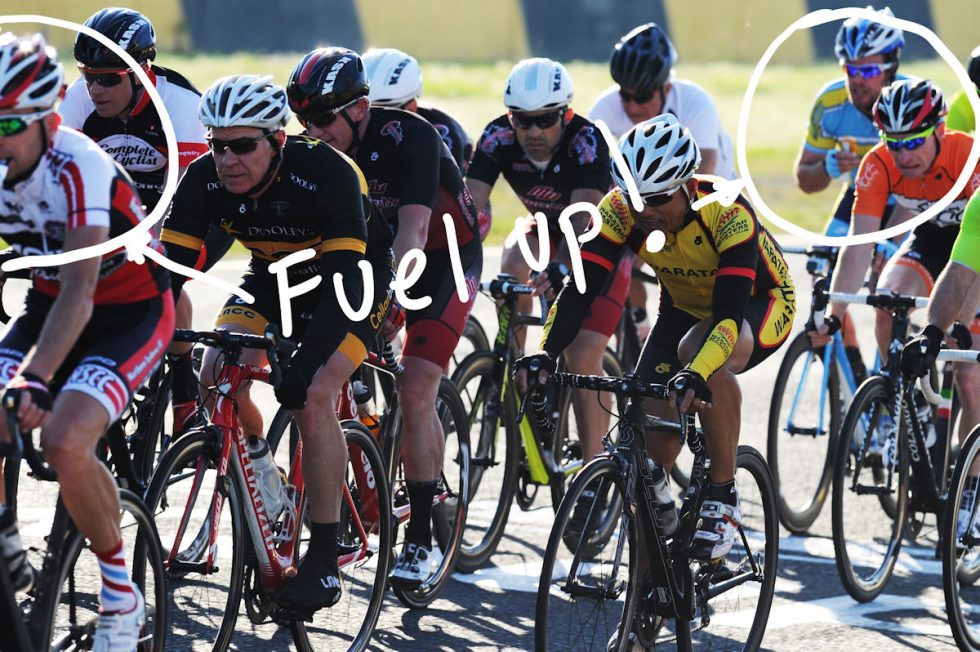I received feedback today that a rider today swung out their arm with a closed…
JACKS BLOG
Is it better to eat before, during or after racing?
Left or Right?
Jockeys mount their horses on the left side. The Hells Angels mount their Harleys from the left side.
Australians drive on the left side and most of us bike riders clip in the left foot first to mount the bike.
But the Europeans and Americans drive on the right side of the road. I remember when we holidayed in Hawaii a couple of years ago and I was silly enough to drive. What a mind bender!
In Australia, it is law that the front brake on a bicycle should be activated by the right lever. Anywhere else in the world, it can be on the left or right. Most of the pro peloton have the front brake controlled by the left lever.
The sports nutrition world says that not only do we need to eat prior to clipping in … we also should eat during racing also.
I neither eat before or during racing.
So who is right?

The need to eat?
I took the opportunity to empty out my race bag recently and found a gel pack with a “best before Sept 2018”.
I parted ways with gel packs 3 years ago and that discovery was a reminder of the time in my life when I lived in the fear of ‘bonking’ (hunger flat). Although I can only remember a single episode in my bike riding life when I felt ‘the bonk’ …. And had to grab some food and drink before I could get going again. That was 40 years ago.
Everyone told me that I had to fuel up before and during a ride to get enough energy to make it to the end. Everyone else was doing it (a search on Google will confirm this)– so I dutifully followed.
Two times during the week, I would wake up at 5am and do the LACC training ride at Olympic Park. It was high intensity stuff. When you are rushed in the early morning, there is no time to eat. So, I did not eat before training.
On the Saturday, It was up at 5am again for a 80 to 100km ride. Again, no time to eat. Sometimes, I would eat a little during the ride and sometimes nothing.
On the Sunday, it was race day. Even if it was a 7am start, I would get up at 5am and have a quick breakfast. All pro riders have breakfast before they race. So, I had to have breakfast too. Just to do a one hour race. And often my stomach would do funny things during the race.
A few years ago, I woke up to the fallacy.
If I could ride over 3 hours on a Saturday without food in the stomach (and not run out of energy at the end), why did I need food for a one hour race?
So, I gave up eating before Sunday racing.
The health stack
Scott Adams came up with the term “talent stack”.
I like to think of my bike racing as a layer of my ‘health stack’. I wrote about breathing previously. It is another layer. Eating is the layer that has grabbed my focus lately.
I have always been guilty of eating too much.
Cutting 5 kgs off my body was not easy. And keeping it off is harder still.
I watch kids playing games and they forget (and even refuse) to have their meals. This makes me believe that If I need to ‘nail’ something, I need to make it a game.
… And if you study the great game players, there is one thing in common. The willingness to explore.
They go deep into the complexities and come back out the rabbit hole with simple tricks that elevate their game to a totally new level. They stack simple things together and magic happens in the execution.
The only way to improve your health is to make it a game.
The two fuel tanks
One of my roofers has a land cruiser and he got cheap fuel the other day. It made the engine sick. He got to work by switching over to his second fuel tank – which still had old fuel. It is handy if you can just switch fuel tanks.
To stay alive and do work, our bodies rely on our energy stores. We have two fuel tanks. The cheap carbohydrate (E10) tank and the high octane (premium) fat tank. It takes ages for the fat tank to fill up because the body has to refine it to double the energy density of the cheap stuff – before putting it away for storage.
When we demand energy, our body switches to the cheap fuel first. It wants to hang on to the precious high octane fuel as long as possible. Work out long enough and our body is forced to switch to fat. But there is one problem.
If our bodies are not adapted to burning fat, it coughs and sputters. This is the ‘bonk’.
So, to avoid this unpleasant situation, we make sure that the cheap fuel tank gets topped up (because everyone says it is the right thing to do). The fat tank stays full. And we wonder why we stay fat after all the working out…
Flicking the switch
There is only one way to flick the switch.
Drain the cheap tank often and force the switch over to high density fat. That means no food until well after the ‘bonk’.
After a while, the body gets clever. It learns that there is lots of energy left to use. And better still, it is high density energy. Even the head gets around to the idea and it does not fabricate the ‘bonk’ any more.
It also finds that fat is the cleaner energy source. It is already there ready to be used. The carbohydrate tank is still waiting for the stomach to process the raw materials to make the glycogen available (and simultaneously using vital energy to do so).
Dual tank mode
What if our bodies can go into dual tank mode?
When the switch is worked enough, it can eventually do the magic of having both tanks working simultaneously. Cheap fuel for fast twitch muscles and high octane for the slow twitch.
Once we have both fuel systems working simultaneously, our bodies start working the way it was designed to function.
Why fast?
The fastest way to deplete the cheap energy tank is to stop eating. Angus Barbieri fasted for 392 days.
I can’t remember doing more than 20 hours.
But I regularly do 15 to 16 hour fasts. Called ‘intermittent fasting”, it has been re-discovered quite recently. Our cavemen ancestors had no option. They ate all the food the night before and when they set out to hunt in the morning, there was no way of knowing when they would score.
It may have been the afternoon before they got lucky.
Faced with the challenge of parting ways with my love of food, I had to game it.
Dinner by 7pm. That means if I don’t eat anything by 7am… I have done 12 hours. Hang on until 10am and I have a 15 hour window for my stomach to relax and clean itself out. Every hour after that is a bonus.
I remember racing the state championships in Orange a few years ago. 10 km into the race, I felt like taking a pee. Every pedal stroke, I felt the urge. Then we hit the climb.
The pee urge was replaced by the urgency of staying with the first five over the climb. The bladder still nudged me every time we slowed down during the race. But as the pace picked up, the focus changed.
My easiest fasting day is a Sunday. Race day means not getting home until after 10am. Some days it is after 11am. By the time I pack up, shower and change, I have hit 16 hours. It is easy when I make it a game to trick myself.
You can imagine how I can duplicate a similar routine on Saturday. Then a few days during the week can also be possible.
After a while (I have been on this for over 2 years), I started to notice things.
If you ever want to know how it feels to operate in ‘dual tank mode’ – then fasting is one way to make it happen.
Survive the battles and win the war
We have been told about crossing the bridge to get to the other side and flattening the curve.
This bridge happens to be worse than Gladesville Bridge. And we still don’t know what is on the other side. But we know that the more prepared we are, the easier to cross the bridge.
We are not meant to win every bike race we enter. Each race is meant to lead to the next one. Together they stack up and we get better at the game.
It is not about flattening one curve – because there will be many more curves to be flattened. It is about being ready for the challenge.
Eventually, we will all get to the other side.
